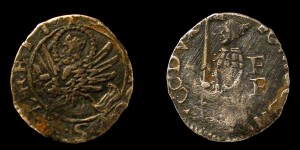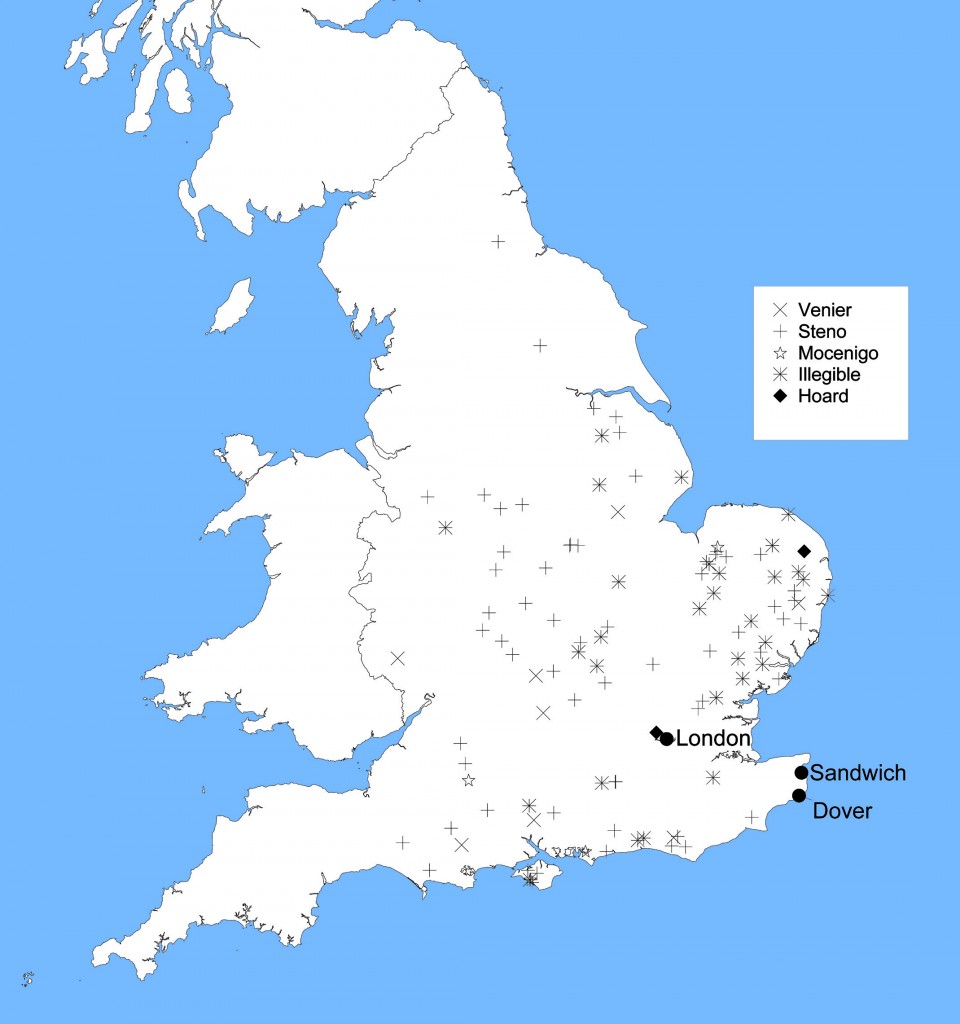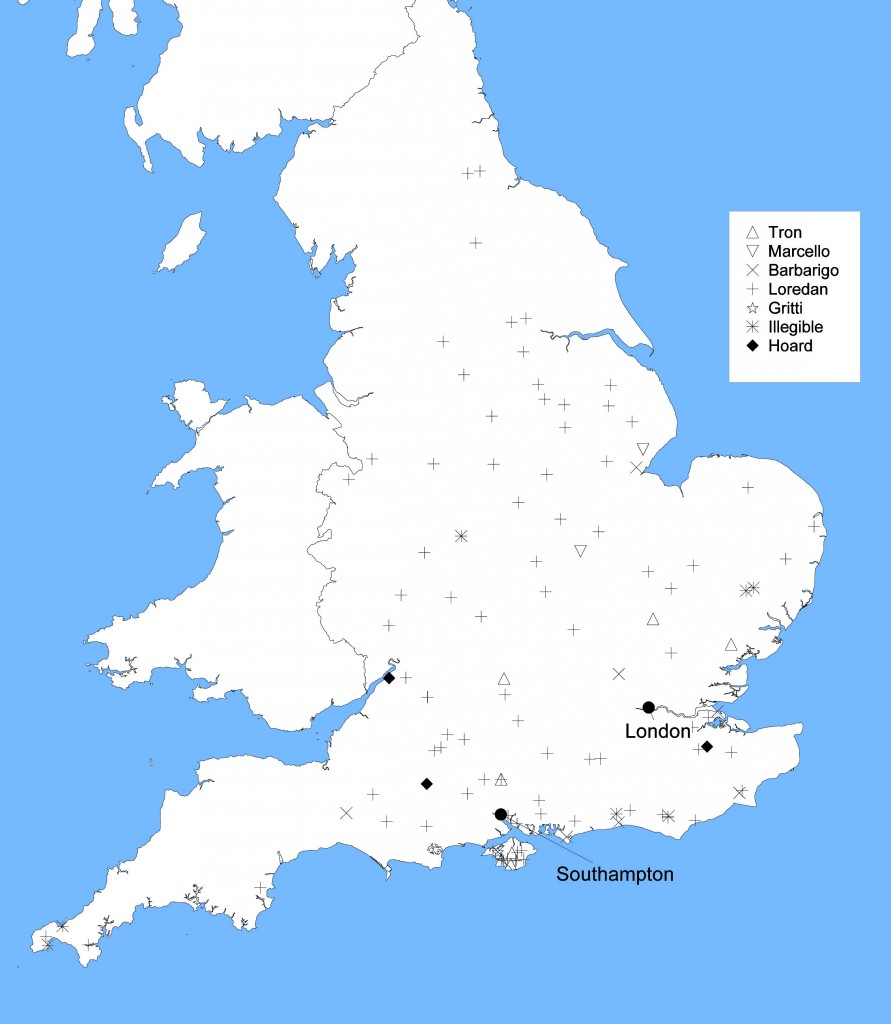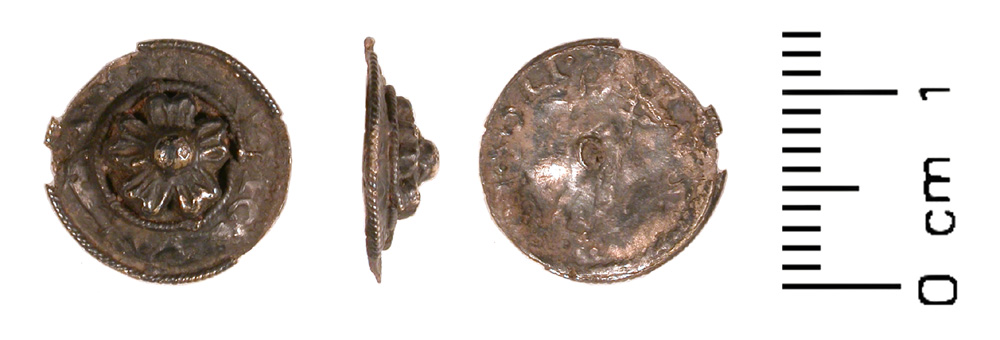On two occasions, in the early 15th and again in the early 16th century, there was a flood of Venetian silver coins into England. These exotic coins, known as ‘soldini’, became nick-named ‘galley-halfpennies’ after the Venetian galley-men who imported them. The reason for the flood of soldini was a serious shortage of English struck halfpennies in circulation. The fallout on the ground was severe, for a lack of pennies, halfpennies, and farthings affected everything from the purchase of bread to the payment of wages. The Venetian soldino was therefore a convenient, though illegal, alternative to the English halfpenny.

Venetian silver soldino of Doge Tomasso Mocenigo (1413-23).
Though the soldino looked like an English halfpenny, it in fact weighed slightly less and had a far lower silver content. So much lower in fact that the Council at Westminster commented in June 1400 that ‘three or four (soldini) are hardly worth one sterling’. Soldini therefore became a particular source of irritation for the English government, which, at various points in the 15th and 16th centuries attempted to rid the country of them through a series of restrictions and seizures.
Venetian merchants were among the most famous of the late medieval period, with trade networks covering the East, the Mediterranean and Northern Europe. Venetian galleys sailed to the East where they acquired luxury goods such as silks and spices, in particular pepper, which were highly sought after in Northern Europe. In the West the Venetian galleys habitually set out for England and Flanders during May and stayed until late August or early September, during which time they traded with England and loaded their galleys with wool and cloth to be sold in Italy, Greece and the Middle East. During the summer month’s soldini entered the English economy through exchange with Venetian merchants and quickly spread across the country.
Today, the Venetian coins of Late Medieval England are familiar due to the large quantity found through metal-detecting and systematically recorded on the Portable Antiquities Scheme database. The database contains information on over 260 examples and show that the majority of coins entered England in two substantial incursions: the first in 1400-c.1415 under Doge Michele Steno, the second in c.1501-1521 under Doge Leonardo Loredano.
The earliest textual evidence for the arrival of Venetian coins comes from a document dated to the year 1400, for which the numismatic evidence is in agreement. In June of that year a number of vessels from the annual trade fleet docked in London and its merchants began trading extensively with soldini. This caught the attention of the Council at Westminster, which promptly sought the advice of King Henry IV. The king took immediate action, instructing the Council to bring the laws against the circulation of foreign coins into force.

Soldini of the first incursion
In July 1400 a proclamation was made ‘strictly forbidding any liege or other man whatsoever henceforward in buying, selling or trafficking to pay or receive silver halfpence of Venice’. The sheriffs of the ports of London, Sandwich, and Dover were duly empowered and charged with the task of seizing any soldini they came across, an order which was repeated in June 1401.
The activities of the sheriffs seem, however, to have had only limited effect. Almost every year between 1400 and 1420, the sheriffs of London and Sandwich rendered account to the Exchequer of small parcels of galyhalpens which they had seized, though rarely did they sieze more than 400 coins in any one year. Clearly policing was a failure. It was now time to tackle the merchants of Venice and their senate directly.
On 28 June 1408, the government sent a writ to the masters of two Venetian galleys ordering them not to trade their coinage in any way. This was supported in 1414 by a directive sent to the mayor and the searcher of the port of London empowering them to forcibly search the galleys. Finally, in 1416, the English government persuaded the Venetian senate to forbid the export of their coinage to London. A Venetian document records this event.
In February 1416 the following decree was made: ‘Decree of the Senate for the fitting out of four galleys for the Flanders and London voyage. In consequence of the prohibition against the currency of Venetian halfpence to London, it is forbidden to take such halfpence to London by the London Galleys. Anyone doing so to be punished; and neither the vice captain, the master, nor any other man may intercede for such offender. The captain is bound before dismissing the London galleys to proclaim this Act on board them.’
Now that the source of coin had been dealt with, the Government turned to tackle Venetian soldini still in general circulation. A proclamation was made in 1415 that ‘all soldini should be taken to the Kings Exchanges to be defaced and sent to be minted. Furthermore, those found with soldini after Easter 1416 were to be heavily fined, with half of the fine to be paid to the informer as reward.’ These measures proved highly effective.
Despite the trauma of the first incursion, the government a hundred years later again failed to strike enough halfpennies. During the late 15th century, Venetian galleys changed their ports of call from London and Sandwich to Southampton. Once again, the lack of English halfpennies was met with a ready supply of similar-sized coins supplied by Venetian merchants; however by this time other batches of coin were arriving overland in ordinary commercial couriers’ bags sent weekly from the major Italian states and terminating at Bruges and Antwerp. A Venetian document records such an event, in which we read of Gerolamo Priuli sending 14,000 soldini overland in five batches in the ordinary commercial couriers’ bags to his brother Vicenzo in London in May, June, and September 1505.

Soldini of the second incursion
All coins of the second incursion were finally removed from circulation with the major re-coinage of silver in England beginning in 1526, though no doubt some were retained as curiosities and souvenirs, and some even to be used as a source of silver for jewellery, such as this button from Harlaston, Suffolk, made from a soldino of Doge Leonardo Loredan.

Silver Venetian soldino of Doge Leonardo Loredan (1501-21) made into a brooch (Treasure Reference no. 2007 T627).
The presence and distribution of these tiny exotic coins tells us that the English government was successful in stamping out the circulation of Venetian coinage shortly after each batch was imported by the galleys. Ironically, however, we find that the government did not learn from its mistakes. Indeed, three further episodes of coin shortage were on the horizon (1640-1670, 1789-1797, and 1810-1820) though in all of these cases the response was large-scale striking of unofficial copper token coinage rather than the importation of foreign silver.